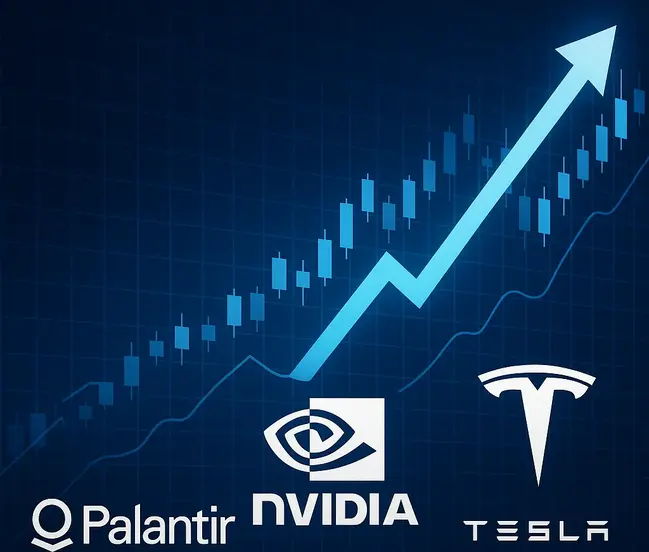The key to successful stock investing isn’t falling in love with companies or developing unshakeable conviction. It’s much simpler than that—follow where Wall Street’s big money is flowing. When institutional investors are buying, retail investors have a much higher probability of success. This approach focuses on reading stock charts to identify when money is entering or leaving positions, rather than trying to predict the future based on fundamentals alone.
The strategy centers on one crucial skill that most retail investors overlook: knowing when to sell. Many investors capture beautiful gains only to give them all back to Wall Street when they hold too long. The solution lies in understanding technical patterns and setting up automated selling systems to protect profits.
Palantir: Consolidation Pattern with Upside Potential
Palantir’s chart reveals a classic consolidation pattern that’s actually quite positive. The stock has established clear resistance around $188, where it consistently hits its head and pulls back. However, the encouraging sign is that every time the stock drops, it finds support and bounces back up, creating a reliable trading range.
This sideways action isn’t necessarily a problem—it represents a period of consolidation where sellers are exhausted and buyers are waiting for the next move. The key entry point for Palantir would be above $190, when it breaks out of this resistance zone. While this might seem counterintuitive (paying more for a stock), it significantly improves the probability of success because all Wall Street traders watch the same technical levels.
Palantir: Consolidation with Breakout Potential
Palantir’s current sideways movement isn’t weakness — it’s energy being stored. Each bounce off support builds momentum for a potential breakout above $190. The moment that happens, the chart flips from consolidation to confirmation — and traders watching these levels will move fast.
Track Market Opportunities →SoFi: Misunderstood Opportunity in Banking Crisis
SoFi presents an interesting opportunity because it’s been unfairly lumped in with the regional banking crisis. Unlike traditional regional banks, SoFi doesn’t operate physical branches, provide loans to small businesses, or carry massive commercial real estate exposure. This misclassification has created a potential buying opportunity.
The chart shows SoFi consolidating in a tighter and tighter range, which typically precedes a directional move. The stock appears to be finding its footing after being oversold due to sector-wide concerns. A breakout above recent highs could signal the next leg up, while any significant dip might present an attractive entry point for those who missed the initial move.
Nvidia: AI Leader in Sideways Consolidation
Nvidia’s chart shows the AI leader in a sideways consolidation pattern since July, which is actually quite normal for a stock that has run as far as it has. The encouraging sign is that the stock has bounced off its 50-day moving average four days in a row, indicating strong dip-buying support from institutional investors.
While not at the most attractive entry point currently, Nvidia remains above key support levels. A breakout above $185-190 would signal the next leg higher, but the more prudent approach would be to wait for a move above previous highs around $190. The AI narrative remains strong, and any significant news in the sector could trigger the next move higher.
AMD: Strong Breakout Following Oracle Deal
AMD presents one of the most compelling charts in the current market. The stock experienced a tremendous breakout following the Oracle deal, creating a significant gap up that it has never filled. This is a very positive technical signal—when a stock gaps up and doesn’t retrace back into the gap, it shows strong institutional buying.
The stock has formed a new resistance level around $235-240, but the last two red days showed very low volume, indicating that sellers are not aggressively taking profits. This suggests investors expect the stock to continue grinding higher. The next breakout would likely occur when AMD moves above $240.
Intel: Building Momentum with AI Client News
Intel’s chart shows a classic “heartbeat pattern” of consolidation followed by breakouts. The stock bounced up, consolidated sideways, broke out again, retraced slightly (normal behavior), and is now consolidating in a higher range. This pattern indicates building momentum and institutional accumulation.
The recent news about a large AI client for Intel’s foundry business has provided additional fundamental support. For entry, the key level to watch is $38 and above. While it might seem counterintuitive to pay more for a stock, breaking above resistance significantly improves the probability of success because it triggers algorithmic buying from Wall Street systems.
Tesla: Sideways Action Ahead of Earnings
Tesla’s chart shows a sideways consolidation pattern with resistance around $450-460. The stock is currently trading at $439, needing to break through this resistance zone to signal the next move higher. However, earnings season presents a challenge for Tesla, as the company is now largely viewed as a car company rather than a growth tech stock.
Earnings reports for car companies rarely provide positive surprises because delivery numbers, production figures, and margins are already known. While Tesla continues to tell compelling stories about future technology, the current chart suggests more sideways action until the next major catalyst emerges.
Apple: Recovery Mode with Resistance Ahead
Apple has managed to recover from a horrible start to the year, showing resilience as the market consistently buys dips. The stock remains well above its 50-day moving average, maintaining its uptrend since August. However, the company faces innovation and growth challenges that limit its upside potential.
The key resistance level to watch is around $257. A breakout above this level would provide momentum for the next leg higher, but currently, the stock shows little volume and momentum as investors wait for earnings season to provide direction.
Market Overview: Strong Uptrend with AI Momentum
The broader market continues to show strength, with the QQQ (NASDAQ ETF) trending upward in almost a straight line since June. Last Friday’s pullback to $589 was quickly bought, and the index has recovered to $604 on good volume. The S&P 500 (SPY) shows a similar pattern, trading at $664 and maintaining its glorious run since May.
The VIX (fear index) has dropped significantly from 28 to 20, indicating reduced market fear and suggesting good things ahead. While not quite back to the low-teen levels of previous weeks, this reduction in fear is a positive signal for continued market strength.




